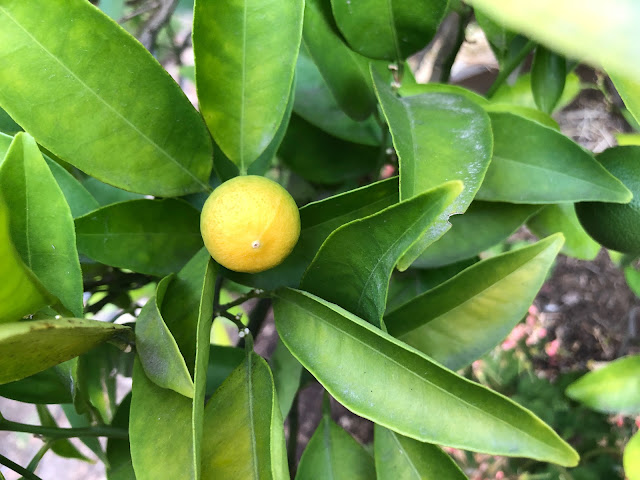
|
|
That little orange is doomed -- sustenance has been cut off by the tree and it
will fall off soon. It's "June drop" time. (Photos: Kathy Morrison)
|
Home garden favorites have a range of quirks
Question: How is an orange tree like a pet cat?
Answer: You love it, even though you don't understand it most of the time.
Really, every lemon, orange, lime, grapefruit and mandarin sold to backyard gardeners should come with an instruction booklet -- or, more realistically these days, a YouTube mini course.
Right now, orange tree owners are flummoxed by a regular occurrence: the "June drop" of excess tiny fruit.
"Aw, gee, look at all these oranges falling off! Must be something wrong. Or maybe it's the weather."
Nope. It's normal. The tree is self-selecting how many oranges it can grow this year. It'll drop as much as 95 percent of the blossoms and fruit it had in spring.
With thanks to UCCE master gardener Bill Krycia, whose citrus class I took in April, here are five more fascinating, flummoxing facts about citrus trees:
1) Commercially sold citrus trees in the U.S. are grafted onto rootstock for hardiness and better production. But the rootstock can and will take over the tree if you let it. Example of the reaction when this happens: "My lemon tree was great for years but now it's producing these bumpy thick-skinned lemons." A significant part of the tree probably died back for some reason -- frost, maybe -- and suckers from the rootstock have taken over. The weird fruit is from the rootstock.
(P.S. The rootstock used for dwarf citrus is called Flying Dragon. I love that name.)

|
|
Can't thank the bees for these beautiful navels-to-be,
on the same tree as the one above. Navel oranges
do not depend on pollinators to set fruit.
|
2) Bees do not pollinate navel oranges. Navel oranges are parthenocarpic (Satsumas, too), meaning they set fruit without pollination or fertilization. All those early blossoms are merely floral -- fun for bees! The later blossoms produced by the tree are the ones that turn into oranges. Seedless oranges, of course. Yes, weird.
3) Citrus trees are evergreen -- they don't drop all their leaves in fall, like apple or pear trees -- and the leaves are multi-taskers. They make food for the tree via photosynthesis, of course, but their additional role is storage. Along with the twigs, branches and roots, the leaves also store excess food (aka photosynthate) through winter. These storage sites are most packed in late winter and early spring, just before spring bloom. This is why citrus shouldn't be pruned then: The fruit yield will be much lower.
4) Citrus varieties easily cross, and the origin of certain varieties is not certain. But this also means new hybrids are being created all the time, especially at UC Riverside, a hotbed of citrus research. The red-fleshed "Valentine" pummelo, for example, is the result of a UCR cross of a pummelo, a blood orange and a mandarin.
5) Some citrus trees, especially mandarins, produce in two-year cycles, with a heavy crop one year, followed by a lighter one. Pruning the tree during the summer before the heavy crop ripens actually can even out this cycle, but who's willing to sacrifice that crop? I know, I know, but do prune if the tree is overburdened and the limbs could break.
For more on growing citrus in the Sacramento area, check out this
Garden Note 127
from the UCCE master gardeners.


